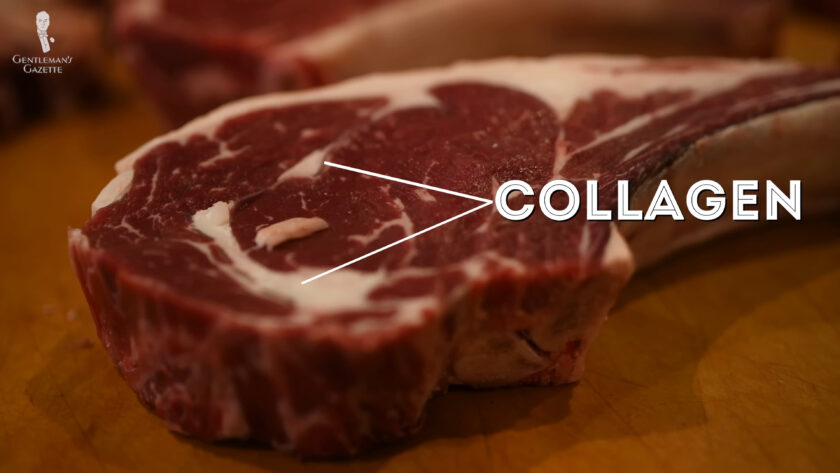Steak: What Consumers Know and Want. Steak is a food that can be described as tender, flavorful, juicy, and cooked to perfection; in fact, most consumers describe their ideal steak as just that: “A tender, flavorful, medium-rare steak that isn’t overly salty.” “Tender, juicy, cooked perfectly and perfectly seasoned.”

What Makes a Steak Tender

The importance of tenderness in a steak cannot be overestimated: tender steaks are easier and more pleasant to chew, and nobody’s idea of a good steak includes a dining experience that resembles chewing on a piece of old leather!
While steaks can be tenderized with a meat-tenderizing mallet, the simplest way to achieve a tender steak is to start with a tender cut of beef. When it comes to tenderness, not all types of steaks are created equal, and no matter how it is cooked or prepared, meat can only be marginally improved from its initial tenderness.
When considering tenderness, let’s first look at the characteristics of the steak itself: ensuring tenderness while cooking is discussed in the third installment in this series.
Muscle Use When the Animal Was Alive
Just as humans exercise different muscles to different degrees, the same is true for cattle. The less a given muscle was used by the cow in question, the more tender the resulting cut of meat will be.
For example, the muscles along the backbone, which constitute many fine and expensive cuts, are used much less than the hips and shoulders, which end up as cheaper cuts.

The Ratio of Muscle, Collagen, and Fat
A steak contains three main types of bodily matter, not counting a bone: muscle, collagen, which is a type of connective tissue that holds muscle together, and fat. Muscle is the primary substance of the steak, fat provides flavor, and collagen provides structure.
During cooking, connective tissues do not have enough time to break down without adversely affecting the flavor of the steak; therefore, tender types of steak should contain less connective tissue overall so that it cannot impact the flavor generally.
Finely marbled fat will melt during cooking, but thicker pockets of fat will not; this excess fat also compromises tenderness. This is why finely but intensely marbled Wagyu or Kobe beef is so prized!

To summarize, the most tender types of steak will come from around the backbone of the cow, have very little connective tissue, and have finely marbled fat. For these reasons, as well as the fact that the more tender muscles are often smaller, you can expect to pay more for tender cuts of steaks.
Tenderness is when the steak is soft and easy to eat. It is made through expert preparation and cooking techniques that break down the connective tissues, leaving the meat soft and easy to cut. A tender steak feels like it’s melting in your mouth, and you don’t need to chew much. It leaves you feeling happy and satisfied after every bite.
Different cuts of steak have varying qualities and this plays a crucial role in determining both tenderness and flavor. Some cuts are naturally more tender, while others are more flavorful due to their muscle composition. Choose a cut that aligns with your preference.
A steak is a cut of meat that is typically obtained from beef, though it can also be sourced from other animals like pork, lamb, or even fish. It is characterized by its thickness and tenderness, often featuring a balance of meat and marbling and small streaks of fat within the muscle fibers that contribute to its flavor and juiciness.
While a well-marbled steak has a juicy texture, lean cuts offer a different kind of tasty experience. To make healthier choices without compromising on taste, go for the lean, red part of the meat. These cuts let you enjoy the natural taste of the meat without lots of fat.
A good steak should feel firm but tender. When you cut it, there should be a little resistance, but it shouldn’t be tough or hard to chew.
Steak Cuts Explained
FAQ
How would you describe a delicious steak?
How would you describe a well done steak?
What does good steak taste like?
How do you describe a steak?
For many, a steak is a delightful culinary experience. Its flavors, textures, and preparation methods can be described in numerous ways. Dive into our list of top adjectives for steak! How to Describe Steak in writing? Steak is a meat slice, usually beef, cooked by broiling, grilling, or frying. Meaning: Streaked with fat.
Skirt steak vs Flank steak: Which is healthier?
Both the steak variants have similar amount of energy and proteins as both are cut from a similar animal. Moreover, skirt steak is cut from the lower portion of the animal, just behind the fore limbs. Flank steak is also cut from the lower part but behind the skirt steak or before the hind limbs. Both the meat variants have characteristic flavor but are not very tender. Thus, they can be used for grilling, roasting, sautéing or broiling. However, the steak should not be cut thickly or over cooked to avoid toughness and dryness.
How do you know if a steak is good?
Try and look for the type of “grade” the steak is: “Prime beef” has the most abundant marbling, “choice beef” has slightly less marbling than prime, and “select beef” has the least amount of marbling. A good balance of fat to meat results in a juicy, tasty steak. 2. Dry the steak out before cooking it.
What are some adjectives for steak?
Here’s the list of words that can be used to describe steak: As you’ve probably noticed, adjectives for ” steak ” are listed above. According to the algorithm that drives this website, the top 5 adjectives for “steak” are: ersatz veal, biggest pseudo, huge rare, thick cultured, and uncommon juicy.
